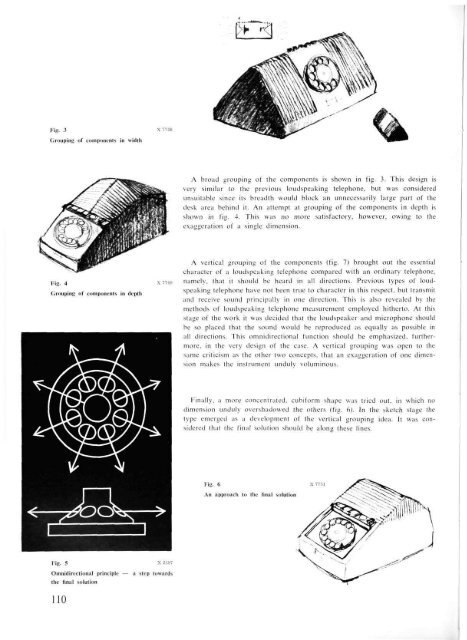1959 - History of Ericsson - History of Ericsson
1959 - History of Ericsson - History of Ericsson
1959 - History of Ericsson - History of Ericsson
You also want an ePaper? Increase the reach of your titles
YUMPU automatically turns print PDFs into web optimized ePapers that Google loves.
Fig. 3<br />
Grouping <strong>of</strong> components in width<br />
Fig. 4<br />
Grouping <strong>of</strong> components in depth<br />
Fig. 5 X 2397<br />
Omnidirectional principle — a step towards<br />
the final solution<br />
110<br />
A broad grouping <strong>of</strong> the components is shown in fig. 3. This design is<br />
very similar to the previous loudspeaking telephone, but was considered<br />
unsuitable since its breadth would block an unnecessarily large part <strong>of</strong> the<br />
desk area behind it. An attempt at grouping <strong>of</strong> the components in depth is<br />
shown in fig. 4. This was no more satisfactory, however, owing to the<br />
exaggeration <strong>of</strong> a single dimension.<br />
A vertical grouping <strong>of</strong> the components (fig. 7) brought out the essential<br />
character <strong>of</strong> a loudspeaking telephone compared with an ordinary telephone,<br />
namely, that it should be heard in all directions. Previous types <strong>of</strong> loudspeaking<br />
telephone have not been true to character in this respect, but transmit<br />
and receive sound principally in one direction. This is also revealed by the<br />
methods <strong>of</strong> loudspeaking telephone measurement employed hitherto. At this<br />
stage <strong>of</strong> the work it was decided that the loudspeaker and microphone should<br />
be so placed that the sound would be reproduced as equally as possible in<br />
all directions. This omnidirectional function should be emphasized, furthermore,<br />
in the very design <strong>of</strong> the case. A vertical grouping was open to the<br />
same criticism as the other two concepts, that an exaggeration <strong>of</strong> one dimension<br />
makes the instrument unduly voluminous.<br />
Finally, a more concentrated, cubiform shape was tried out, in which no<br />
dimension unduly overshadowed the others (fig. 6). In the sketch stage the<br />
type emerged as a development <strong>of</strong> the vertical grouping idea. It was considered<br />
that the final solution should be along these lines.<br />
Fig. 6 x 7751<br />
An approach to the final solution
















